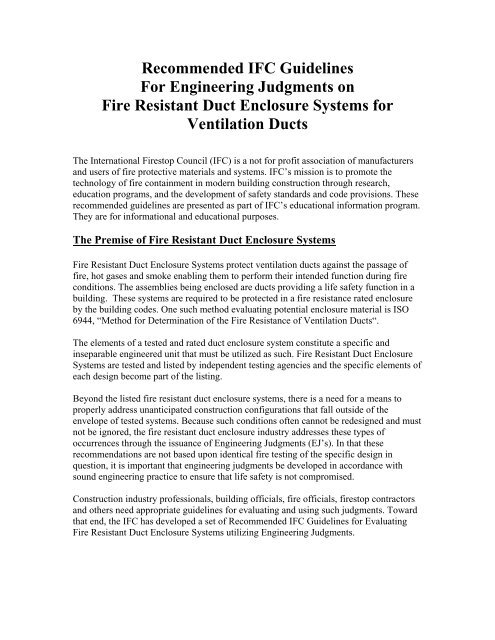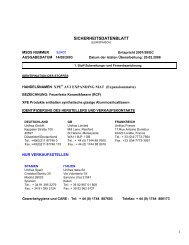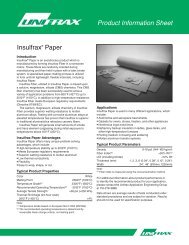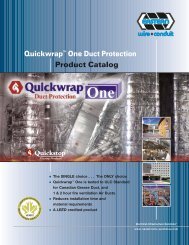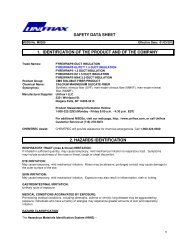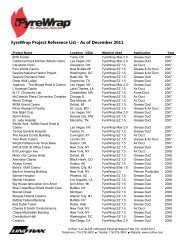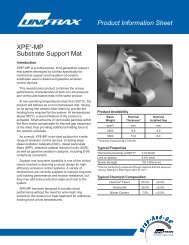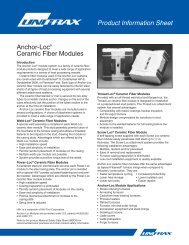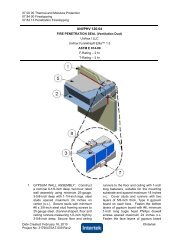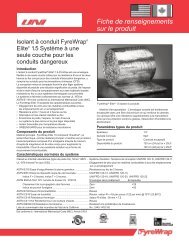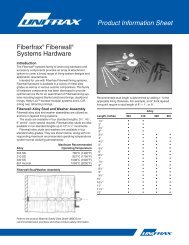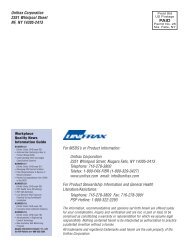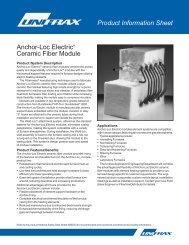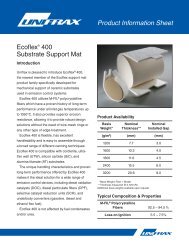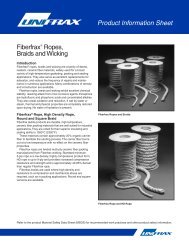Recommended IFC Guidelines For Engineering Judgments ... - Unifrax
Recommended IFC Guidelines For Engineering Judgments ... - Unifrax
Recommended IFC Guidelines For Engineering Judgments ... - Unifrax
You also want an ePaper? Increase the reach of your titles
YUMPU automatically turns print PDFs into web optimized ePapers that Google loves.
<strong>Recommended</strong> <strong>IFC</strong> <strong>Guidelines</strong><br />
<strong>For</strong> <strong>Engineering</strong> <strong>Judgments</strong> on<br />
Fire Resistant Duct Enclosure Systems for<br />
Ventilation Ducts<br />
The International Firestop Council (<strong>IFC</strong>) is a not for profit association of manufacturers<br />
and users of fire protective materials and systems. <strong>IFC</strong>’s mission is to promote the<br />
technology of fire containment in modern building construction through research,<br />
education programs, and the development of safety standards and code provisions. These<br />
recommended guidelines are presented as part of <strong>IFC</strong>’s educational information program.<br />
They are for informational and educational purposes.<br />
The Premise of Fire Resistant Duct Enclosure Systems<br />
Fire Resistant Duct Enclosure Systems protect ventilation ducts against the passage of<br />
fire, hot gases and smoke enabling them to perform their intended function during fire<br />
conditions. The assemblies being enclosed are ducts providing a life safety function in a<br />
building. These systems are required to be protected in a fire resistance rated enclosure<br />
by the building codes. One such method evaluating potential enclosure material is ISO<br />
6944, “Method for Determination of the Fire Resistance of Ventilation Ducts“.<br />
The elements of a tested and rated duct enclosure system constitute a specific and<br />
inseparable engineered unit that must be utilized as such. Fire Resistant Duct Enclosure<br />
Systems are tested and listed by independent testing agencies and the specific elements of<br />
each design become part of the listing.<br />
Beyond the listed fire resistant duct enclosure systems, there is a need for a means to<br />
properly address unanticipated construction configurations that fall outside of the<br />
envelope of tested systems. Because such conditions often cannot be redesigned and must<br />
not be ignored, the fire resistant duct enclosure industry addresses these types of<br />
occurrences through the issuance of <strong>Engineering</strong> <strong>Judgments</strong> (EJ’s). In that these<br />
recommendations are not based upon identical fire testing of the specific design in<br />
question, it is important that engineering judgments be developed in accordance with<br />
sound engineering practice to ensure that life safety is not compromised.<br />
Construction industry professionals, building officials, fire officials, firestop contractors<br />
and others need appropriate guidelines for evaluating and using such judgments. Toward<br />
that end, the <strong>IFC</strong> has developed a set of <strong>Recommended</strong> <strong>IFC</strong> <strong>Guidelines</strong> for Evaluating<br />
Fire Resistant Duct Enclosure Systems utilizing <strong>Engineering</strong> <strong>Judgments</strong>.
<strong>IFC</strong> EJ <strong>Guidelines</strong><br />
Fire Resistant Duct Enclosure Systems <strong>Engineering</strong> <strong>Judgments</strong> should:<br />
1. Not be used in lieu of tested systems when available;<br />
2. Be issued only by Fire Resistant Duct Enclosure Manufacturer’s qualified<br />
technical personnel or, in concert with the manufacturer, by a knowledgeable<br />
registered Professional Engineer, or Fire Protection Engineer, or an independent<br />
testing agency that provides listing services for fire resistant duct enclosure<br />
systems;<br />
3. Be based upon interpolation of previously tested fire resistant duct enclosure<br />
systems that are either sufficiently similar in nature or clearly bracket the<br />
conditions upon which the judgment is to be given. Additional knowledge and<br />
technical interpretations based upon accepted engineering principles, fire science<br />
and fire testing guidelines (e.g. ASTM E 2032 – Standard Guide for Extension<br />
of Data from Fire Endurance Tests) may also be used as further justification;<br />
4. Be based upon full knowledge of the elements of the construction, and their<br />
behavior, within close proximity of the fire resistant duct enclosure system;<br />
5. Be limited only to the specific conditions and configurations upon which the<br />
engineering judgment was rendered and should be based upon reasonable<br />
performance expectations for the recommended fire resistant duct enclosure<br />
systems under those conditions;<br />
6. Be accepted only for a single specific job and project location and should not be<br />
transferred to any other job or project location without thorough and appropriate<br />
review of all aspects of the next job or location’s circumstances;<br />
Minimum Suggested Content<br />
Proper Fire Resistant Duct Enclosure Systems <strong>Engineering</strong> <strong>Judgments</strong> should:<br />
1. Be presented in appropriately descriptive written form with or without detail<br />
drawings as may be deemed necessary;<br />
2. Clearly indicate that the recommended fire resistant duct enclosure system is an<br />
engineering judgment;<br />
3. Include clear directions for the installation of the recommended fire resistant<br />
duct enclosure system;<br />
4. Include dates of issue and authorization signature as well as the issuer’s name,<br />
address and telephone number;<br />
5. Reference tested system(s) which design (EJ) is based on;<br />
6. Identify the job name, project location and firm EJ is issued for along with the<br />
non-standard conditions and rating supported by the EJ;<br />
7. Have relevant documentation (i.e., UL, ULC, OPL, Intertek, SwRI or other<br />
independent laboratory system(s), test report(s), and or opinions);<br />
8. Provide complete descriptions of critical elements for the fire resistant duct<br />
enclosure system configuration. These should include, but are not limited to the<br />
following:
a. Duct System Type - e.g., stair pressurization, smoke exhaust, etc;<br />
b. Duct Construction – dimensions, material, gauge, reinforcement,<br />
connections, orientation (horizontal, vertical or both), pressure rating on<br />
duct system;<br />
c. Enclosure System – brand name designation, description, fire resistance<br />
rating;<br />
• Thickness, density, number of layers, fire rating<br />
• Installation details such as mechanical attachments, material<br />
joints/overlaps, duct support system<br />
• Firestop System – annular space dimensions, floor/wall<br />
construction, design number, components, installed thickness.<br />
Please refer to <strong>IFC</strong> Guideline for Evaluating Firestop Systems<br />
<strong>Engineering</strong> <strong>Judgments</strong> for additional details.<br />
<strong>IFC</strong> recommends that these guidelines be considered in evaluating whether any fire<br />
resistant duct enclosure system engineering judgment meets minimal requirements.<br />
Questions concerning the EJ request should be addressed to the initiator of the judgment.<br />
<strong>IFC</strong> recommends that the AHJ be consulted regarding the EJ prior to the installation of<br />
the fire resistant duct enclosure system.<br />
Revision 1 April 23, 2008


